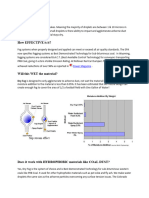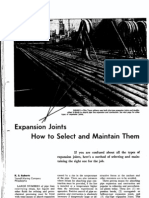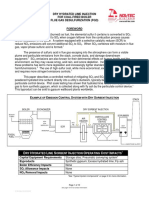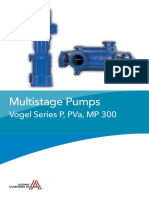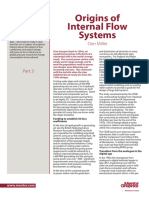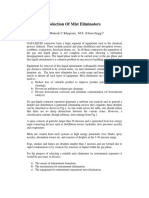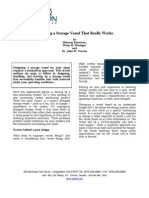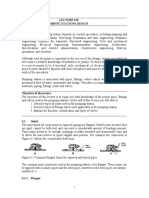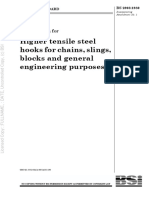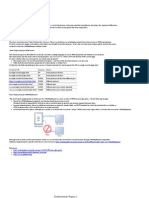Best Practices For Pilot-Plant Piping: Fluids and Solids Handling
Best Practices For Pilot-Plant Piping: Fluids and Solids Handling
Uploaded by
Teguh SetionoCopyright:
Available Formats
Best Practices For Pilot-Plant Piping: Fluids and Solids Handling
Best Practices For Pilot-Plant Piping: Fluids and Solids Handling
Uploaded by
Teguh SetionoOriginal Title
Copyright
Available Formats
Share this document
Did you find this document useful?
Is this content inappropriate?
Copyright:
Available Formats
Best Practices For Pilot-Plant Piping: Fluids and Solids Handling
Best Practices For Pilot-Plant Piping: Fluids and Solids Handling
Uploaded by
Teguh SetionoCopyright:
Available Formats
Fluids and Solids Handling
Best Practices for
Pilot-Plant Piping
Richard Palluzi, P.E.
ExxonMobil
Research & Engineering Co.
Pilot-plant piping is subject to more-frequent
modification than typical process plant piping,
and must be able to accommodate a range of media,
temperatures, and pressures during its lifetime.
Use this guide to determine which piping, tubing, and
fittings are optimal for your pilot plant application.
ilot-plant piping and process-plant piping differ
in numerous ways. Pilot plants are smaller, have a
more-compact footprint (Figure 1), are modified more
frequently, and are often subject to more-frequent cleaning
and inspection. Their piping is also likely to handle a wider
range of materials, often with unknown or incompletely
known properties, which may lead to unexpected clogging,
corrosion, higher pressure drops, and numerous similar
problems.
Leakage or, more accurately, the resistance to
leakage is a critical concern in most pilot-plant piping
systems. Pilot plants are more susceptible to leakage than
process plants. Because they continually undergo modification, they need to be flexible and accommodate accessibility
p Figure 1. Pilot plants come in a variety of sizes, but are typically smaller
than process plants. This pilot plant, used for petrochemical research, is
about average size.
Copyright 2014 American Institute of Chemical Engineers (AIChE)
and change. As a result, pilot-plant piping systems contain
an inordinately large number of fittings and joints, all of
which are potential leak points.
The ideal piping for a pilot plant is leak resistant, easily
modified, able to accommodate varying requirements, easy
to install, low cost, offered in many different materials of
construction, available in all sizes, and has fittings available
in numerous configurations a challenging list under the
best of circumstances! Unfortunately, this ideal piping does
not exist, and tradeoffs are inevitable.
The most common types of piping, tubing, and fittings
used in pilot plants are:
pipe with threaded fittings
welded and flanged pipe
tubing with compression fittings
tubing with vacuum fittings
grooved pipe with grooved fittings
tubing or pipe with sanitary fittings.
This article describes best practices for choosing,
designing, and installing pilot-plant piping, and guides
selection among the most popular types of piping, tubing,
and fittings.
Standard threaded piping
Standard threaded piping and fittings (Figure 2) have
the advantages of being low cost, readily available, and
easy to install. However, they are prone to leakage, which is
aggravated by their lack of resistance to vibration and even
small temperature swings. Their use in gas service is not
recommended, particularly in sizes above 1 in. nominal pipe
size (NPS). Most pilot plants should limit the use of standard
CEP April 2014 www.aiche.org/cep
39
Fluids and Solids Handling
threaded pipe and fittings (Figure 3) to low-pressure utility
systems.
It is good practice to ensure that the die the facility uses
to cut threads into its pipes is sharp and in good condition;
otherwise, the threads are likely to be rounded and more
prone to leakage. The die should also be suitable for the
materials of construction. Stainless steel piping, for example,
requires a specific high-strength steel die; using a carbon
steel die will lead to a very short pipe life or more commonly poor threads. And, it is important to make sure the
threading is the right length, as longer or shorter lengths are
more prone to leakage.
Specify high-quality fittings. Low-grade fittings, even if
they meet all applicable national standards, are more prone
to leakage because they are subject to less-rigorous quality
control during their manufacture.
Unions (i.e., the pipe fittings that join sections of pipe
together), in particular, should always be of the highest possible quality. The difference between the performance of a
high-end (and more expensive) union and a low-end (and
cheaper) one is significant after the first few uses. Avoid
threaded connections in cyclic service, whether the temperature or the pressure cycles, as the interference fit that creates
the threads seal does not hold up when cycled.
Welded piping
Welded piping with flanged joints (Figure 4) the most
common process-plant piping is more rare in pilot-plant
service because it is difficult to modify and hard to find in
small sizes. Finding flanges for piping smaller than 1 in. iron
pipe size (IPS) is difficult, and almost impossible for sizes
below 0.5 in. IPS. Tubing is almost always a better choice,
as discussed later.
Large pilot plants that can utilize welding (e.g., those that
have large piping and are not likely to require major renovations) should use raised-face flanges whenever possible, as
they require less force to seal, have a longer service life,
and are more resistant to leakage than flat-faced flanges
(Figure 5). Avoid the use of threaded flanges, as these add
another potential leak point and often make bolt alignment
difficult if the flange must be retightened.
p Figure 2. Standard threaded fittings come in a variety of styles and
sizes, and are readily available from many manufacturers.
p Figure 4. Flanged joints are typically only available in large pipe sizes,
and nearly impossible to find below 0.5 in. IPS. Photo courtesy of Zeton, Inc.
(a)
p Figure 3. Standard threaded piping and fittings are used on this pilot
plant vessel.
40
www.aiche.org/cep April 2014 CEP
(b)
(c)
p Figure 5. When choosing a flange for welded piping, raised-face flanges
(b) should be used whenever possible, as they are more resistant to leakage than flat-faced flanges (a). Threaded flanges (c) should be avoided.
Copyright 2014 American Institute of Chemical Engineers (AIChE)
Tubing with compression fittings
Tubing with compression fittings is usually a best
practice for pilot-plant piping. Tubing and compression fittings range in size from 1/16 in. to 1.5 in., though the most
common sizes are 1/8 in. to 1 in. They can be constructed of
materials such as stainless steels, Hastelloy, Inconel, Monel,
and numerous plastics.
Tubing is easy to install and, since it can be bent,
elbows with their potential for leakage are eliminated
(Figure 6). Bending also allows for intricate shapes and
specialized construction, such as heating/cooling coils and
tube-in-tube heat exchangers. It is easier to install tubing
than piping in cramped locations.
The connections on each compression fitting can be
opened for cleaning, draining, flushing, or modification at
every joint without having to unscrew long lengths of piping, as required with threaded fittings. (Some clearance is
needed to spring the fittings, but this is usually available.)
Although more expensive than threaded fittings, compression fittings are easier to install even by less-skilled
personnel and require fewer specialized tools. The labor
p Figure 6. Tubing and compression fittings are frequently used in pilot
plants. Tubing is easy to install and can be bent, which allows for intricate
shapes and specialized construction. Photo courtesy of Zeton, Inc.
Assembled Compression Fitting
(Tube not shown)
Front
Ferrule
savings generally make tubing with compression fittings less
expensive overall than any other type of piping.
Compression fittings are also more leak resistant than
threaded fittings (although not as leak resistant as welded
piping). They produce a more-leakfree pilot plant, which has
significant long-term operational advantages, such as reduced
maintenance, improved safety, and better material balances.
Compression fittings have a significantly longer lifespan
than threaded fittings. They can typically be opened and
closed numerous times before they need to be replaced.
Many types of specialty fittings are available, including
reducers, thermocouple-insertion fittings, and tees with different port sizes. More importantly, many small valves with
compression-fitting ends are available. Use of these valves
and specialty fittings helps to save space in a pilot plant,
reduce potential leak points, and provide for easier cleaning
and modification.
The use of compression fittings imposes limitations on
tubing hardness therefore, it is critical to specify tubing
within the fittings range. The compression-fitting ferrule
(i.e., the metal piece that digs into the front of the tubing to
create a seal) will not swage (or compress) properly onto
tubing that is too hard (Figure 7). Compression fittings larger
than 3/4 in. require considerable force to properly swage the
ferrule. Hydraulic swagers (devices that use hydraulic power
to create the fitting) are available and should be considered,
particularly for units with numerous larger fittings.
Compression fittings also have minimum and maximum
wall-thickness limits. If the wall is too thin, the tubing may
crumple or collapse without swaging; if it is too thick, the
large force required to swage the fitting might be difficult to
achieve without the use of a hydraulic unit.
Compression fittings can be drilled through to allow
insertion of thermocouples or dip tubes (Figure 8). However,
this modification significantly reduces the pressure rating of
the fittings, often by 2570%, depending on the vendor and
the size of the fitting (Table 1).
Fitting Nut
p Figure 8. Compression fittings can be drilled through to allow tubing to
be used as a dip leg.
Table 1. The pressure rating of a drilled-through
compression fitting is reduced, or derated.
Fitting Body
Rear Ferrule
Tube
p Figure 7. A compression fitting consists of a fitting nut, rear ferrule, front
ferrule, and fitting body. The ferrule assembly swages to the tube when the
fitting nut is tightened.
Tubing Outer Dia., in.
Typical Pressure Derating
1/2 and less
25%
5/8 3/4
50%
7/8 1
75%
Article continues on next page
Copyright 2014 American Institute of Chemical Engineers (AIChE)
CEP April 2014 www.aiche.org/cep
41
Fluids and Solids Handling
Standard compression fittings can typically withstand
pressures to about 6,000 psig. Longer ferrule designs are
available that can withstand up to 15,000 psig, albeit at
a higher cost. Valves are also readily available for these
designs, although the selection is more limited and their
costs are higher. For pressures above 15,000 psig, cone-andcollar style fittings are more appropriate.
In general, heavy-wall tubing is coned (tapered at the
end) and has a captured ferrule threaded onto the tubing. These cone-and-collar style fittings are suitable up to
60,000 psig, and they can sometimes be used at even higher
pressures. However, there are few vendors who offer these
fittings, and there are even fewer types of valves available.
These components have significantly higher costs than
standard fittings, and they require a higher skill level and
more time for installation. The performance, leakage, and
lifespan of these higher-pressure designs is equivalent to that
of standard compression fittings.
Vacuum fittings
Tubing can also employ vacuum fittings (Figure 9).
Typically sold by the same vendors that offer compression
fittings, vacuum fittings have significant advantages over
compression fittings. They have a gasket between the pieces
of the fitting, and simply replacing the gasket can help
extend their lifespan (Figure 10). They have significantly
better leak resistance than compression fittings, particularly
when exposed to temperature differentials.
However, they are more expensive than compression
fittings, and the costs of gasket replacement add to their
operating costs. Vacuum fittings are also larger than corresponding compression fittings, which can create issues
for very tight assemblies, but their zero-clearance feature
(i.e., fittings that require no clearance for removal) usually
compensates for this slight increase in size. Many vacuum
fittings can be welded to the tubing; although this further
reduces leakage, it also increases the costs to install the fittings, as well as the skill level required for the installation.
But, this extra cost is often justified. Although the sealing
surface can be damaged, if the installer is aware of this
potential, simple care can avoid damage.
Gaskets are available in metal and elastomeric materials,
but each type requires totally different fittings. Temperature
is normally the deciding factor, with metal gaskets suitable
for use at much higher temperatures. Corrosion, and less
frequently pressure rating, may also dictate the final choice.
Grooved piping and fittings
Grooved piping and fittings (Figure 11) are not commonly used in pilot plants. They allow easy disassembly, but
require specialty tools and skills to make the grooves in the
piping. Large sizes are readily available, but smaller sizes,
less than 1 in., are rare. Typically available in stainless steel
and carbon steel, their use in pilot plants is generally limited
to larger process piping (2 in. and above) for which easy
assembly/disassembly is important.
p Figure 9. Vacuum fittings have a gasket between the pieces of the
fitting, which helps provide leak resistance and longer life. This example
of a vacuum fitting has a black elastomeric (O-ring) gasket.
Sanitary fittings
Sanitary fittings are gasketed fittings designed to be
welded to heavy-walled tubing or light-walled piping. They
are available in only Type 304 or Type 316 stainless steel,
and are generally restricted to applications with pressures
of 250 psig or less; a very limited selection is available for
use at pressures up to 1,000 psig. Sanitary fittings are very
expensive and come in sizes of 1/21 in. and larger. They
p Figure 10. This vacuum fitting has a metallic gasket. It is shown open
(or disassembled) in the top photo, and closed (assembled) in the bottom
photo.
p Figure 11. Grooved piping and fittings are available in larger sizes, but
these sizes are often too large for most pilot plants. Photo courtesy
of Zeton, Inc.
42
www.aiche.org/cep April 2014 CEP
Copyright 2014 American Institute of Chemical Engineers (AIChE)
are designed to be easily cleaned or sterilized, which makes
them of interest to the food and pharmaceutical industries.
However, their higher costs, lower pressure ratings, limited
materials of construction, and need for welding typically
limit their use to specialized units (Figure 12).
Best practices
Given these numerous choices, here are some best practices to consider when choosing pilot-plant piping.
Use vacuum fittings where frequent removal or cleaning
is required, as their zero-clearance design makes layout and
changeout easier. The ability to replace their gaskets maximizes service life.
Consider welded joints for connections that will not need
to be opened or are on systems subject to routine or frequent
temperature swings, as well as for connections that are in
difficult-to-reach locations or under insulation. These connections have the lowest potential for leakage.
Compression fittings require bending at one or more
joints for removal. The stress placed on the adjacent connections (which are not being directly made or broken) during
bending often creates additional leakage. Even if both ends
of the bent section are removed, bending shortens a fittings
service life.
Tubing, while much more flexible and less prone to leakage than piping, is inherently weaker. Therefore, to avoid
leakage, mount the valves, not the tubing, wherever possible
(Figure 13). The very act of turning a valve can, over time,
create stresses that cause additional leakage at the valve connections. Similarly, avoid unsupported elements (e.g., regulators, filters, etc.), long spans (those over 2436 in.), heavier
components (Figure 14), and flimsy supports. All lead to
increased leakage in the long term.
Whether tubing or piping is used, plan the installation
and mounting with bends to allow for thermal expansion
whenever possible. Bends allow the tubing to expand and
contract and limit the forces on fittings, which results in
fewer leaks over time. Even small temperature swings
(510F), over time, can cause leaks.
Use specialty fittings to minimize the number of joints
and potential for leaks. The large number of specialty tubing
fittings available can help make this easier. Although more
expensive initially, the long-term savings outweigh the initial
costs. Some specialized fittings have longer delivery times,
so this may require some planning and/or stocking.
When laying out the pilot plant and determining how
to mount components, remember that almost everything
eventually needs maintenance. Make sure the mounting and
layout allow easy removal of instruments, rotating equipment, filters and strainers, reactors, regulators, relief devices,
control valves, and similar equipment (Figure 15).
The single best practice in pilot plant layout is to spend
time planning where everything will go and leave considerable extra room beyond what you believe is necessary. Even the most detailed and carefully planned layout
typically fails to take into account all the supports, protrusions, viewing angles, adjustment requirements, insulation,
utilities, wiring, piping runs, and numerous other small items
p Figure 13. Mounting the valves, instead of the tubing, can lower stress
on tubing and prevent leaks.
p Figure 12. Two sanitary fittings and a piece of piping are used to create
a vessel.
Copyright 2014 American Institute of Chemical Engineers (AIChE)
p Figure 14. Heavy equipment requires specialized mounting to minimize
stress on the tubing.
CEP
April 2014 www.aiche.org/cep
43
Fluids and Solids Handling
that add up and require large amounts of extra space. No
matter how good the designer, no matter how detailed the
layout drawing (2D or 3D), and no matter how careful the
planners are to include everything in the design, the actual
installation in the field almost always requires more space
than expected.
Similarly, trying to ensure an operable and ergonomic
pilot plant layout almost always ends up using more space
than the best layout drawing suggests. The realization that
a component is just a little too high, a hair too low, a bit too
far to the left, or would be much easier to operate if it were a
tad to the right ends up costing inches that rapidly add up to
feet. We allot contingency an allowance for unknown but
historically predictable items on timed project schedules
without hesitation. We must do the same for space on a pilot
plant layout.
Another reason for allocating additional excess space
is that pilot plants are continually being modified. These
modifications can be made faster and easier, and produce
a more operable pilot plant, when there is adequate space
p Figure 15. This pilot plant has adequate room for maintenance and
modifications.
p Figure 16. Use a holdback (black wrench) whenever tightening or
loosening a fitting on threaded piping to avoid excess stress on adjacent
fittings.
44
www.aiche.org/cep
April 2014
CEP
nearby. Conversely, cramped units can require substantial
rework during modification, which is both time consuming
and costly. Such modified layouts are neither ergonomic nor
easy to operate. The initial costs of the extra space are usually minimal compared to the long-term savings it produces.
A good rule of thumb is that a pilot plant almost always
ends up requiring 50% more space than any but the most
detailed layouts suggest. An additional 50% excess space is
a prudent investment for inevitable future modifications. At
best, an excellent detailed layout drawing by an experienced
pilot plant designer might reduce this to 25%. Building a
pilot plant in a space that is too small adds to construction
costs, makes future changes difficult or impossible, and
greatly increases maintenance costs.
Operators and process engineers should be trained in
these best practices to keep their pilot-plant piping leakfree
for long-term service. For example, it is important to use a
holdback whenever making or breaking any fitting to avoid
excess stress on adjacent fittings (Figure 16).
Buying higher-quality pipe, tubing, and fittings almost
always has lower long-term costs. Higher-quality gaskets
and sealants similarly produce better seals and permit less
leakage. Polytetrafluoroethylene (PTFE, e.g., Teflon) tape
and pastes generally work better than simple pipe dopes
(i.e., low-cost sealants). However, both pastes and dopes
require a minimum time for hardening before use. Proper
sealing must be used on all piping. Silver-plated vacuum
gaskets seal better than plain stainless gaskets and cost only
slightly more. Spiral reinforced gaskets generally seal easier
and last longer than flat gaskets. Paying more for a goodquality seal is always more cost effective.
In summary, most of the best practices for pilot-plant
piping rely on understanding the strengths and weaknesses
of the systems, mounting components properly, and providCEP
ing adequate space to lay the unit out efficiently.
RichaRd Palluzi, P.E., cSP, is a Distinguished Engineering Associate at
ExxonMobil Research and Engineering Co. (1545 Route 22 East, Annandale, NJ 08801; Phone: (908) 730-2323; Email: Richard.p.palluzi@
exxonmobil.com), where he is responsible for the design, construction,
and support of pilot plants and laboratories at ExxonMobils research
site in Clinton, NJ. He chaired the Clinton sites Safe Operations Team,
which is responsible for reviewing and approving all pilot plant and
laboratory installations and operations, and chaired ExxonMobils
Pilot Plant and Laboratory Safety Standards Committee, which is
responsible for the development and dissemination of more than 100
internal company standards on pilot plant design and construction.
He has a BE and an ME in chemical engineering from Stevens Institute
of Technology, and is a registered professional engineer in New Jersey
and a Certified Safety Professional (CSP). He is the author of two
books, 50 articles, and 40 presentations on all phases of pilot plant
and laboratory safety and operations. He is a member of AIChE and
past chair of the Process Development Divisions Area 12b, Pilot Plants;
a member of the National Fire Protection Associations committees on
NFPA 45 Fire Protection for Laboratories using Chemicals and NFPA 55
Medical and Industrial Gases; and a member of the American Society
of Safety Engineers.
Copyright 2014 American Institute of Chemical Engineers (AIChE)
You might also like
- Dry FogDocument5 pagesDry Fogmshah222No ratings yet
- Contractor's Guide for Installation of Gasketed PVC Pipe for Water / for SewerFrom EverandContractor's Guide for Installation of Gasketed PVC Pipe for Water / for SewerRating: 5 out of 5 stars5/5 (1)
- Statistical Analysis Plan (SAP) Checklist V 1.0 2019: Section/Item Index Description Reported On Page #Document3 pagesStatistical Analysis Plan (SAP) Checklist V 1.0 2019: Section/Item Index Description Reported On Page #RosaNo ratings yet
- Expansion Joints How To Select and Maintain ThemDocument6 pagesExpansion Joints How To Select and Maintain ThemSeungmin PaekNo ratings yet
- Simulation of Crude Distillation Unit ofDocument6 pagesSimulation of Crude Distillation Unit ofSiddharth SharmaNo ratings yet
- Modular Pilot Plant ConstructionDocument4 pagesModular Pilot Plant ConstructionNattapong PongbootNo ratings yet
- Pilot Plant Design SpecificationsDocument3 pagesPilot Plant Design Specificationschemsac2No ratings yet
- Stress Corrosion Cracking - A Caustic ExperienceDocument3 pagesStress Corrosion Cracking - A Caustic Experienceramadoss_alwar7307No ratings yet
- Motorreductores BaldorDocument52 pagesMotorreductores BaldorADRIAN MENDEZ RICARIONo ratings yet
- Plate Girder Behaviour and DesignDocument48 pagesPlate Girder Behaviour and DesignayingbaNo ratings yet
- Heat Exchanger Reference TheoryDocument23 pagesHeat Exchanger Reference TheoryMurugan VeluNo ratings yet
- Facts at Your Fingertips-201007-Conservation Economics Carbon Pricing ImpactsDocument1 pageFacts at Your Fingertips-201007-Conservation Economics Carbon Pricing Impactsonizuka-t2263No ratings yet
- Vacuum Belt Filter LeibleinDocument3 pagesVacuum Belt Filter LeibleinPrince ChaudharyNo ratings yet
- C9MDocument1 pageC9MГоран ЈараковићNo ratings yet
- Flygt Jetmixers Mixing PDFDocument8 pagesFlygt Jetmixers Mixing PDFJaison JoseNo ratings yet
- 53025tpnews 11112020Document40 pages53025tpnews 11112020Hatem AbdelfattahNo ratings yet
- ICUE Presentation - Johnson GDocument21 pagesICUE Presentation - Johnson Gemeargrusty1No ratings yet
- Sorbent - Injection Line InjectionDocument10 pagesSorbent - Injection Line InjectionmadyaNo ratings yet
- Bracing ConnectionDocument16 pagesBracing ConnectionMa N U VenusNo ratings yet
- High Temperature Pneumatic ConveyingDocument7 pagesHigh Temperature Pneumatic Conveying설동하No ratings yet
- Co 2 ExtractionDocument7 pagesCo 2 ExtractionthumperwardNo ratings yet
- Autoclave PDFDocument8 pagesAutoclave PDFDïëgöNïïckYtzNo ratings yet
- Tivar 88-2: Drop-In Liners Solve Flow ProblemsDocument1 pageTivar 88-2: Drop-In Liners Solve Flow Problemsacas35100% (1)
- 61 MC Elvain Cave Durand Bingham Fluids HR ValueDocument12 pages61 MC Elvain Cave Durand Bingham Fluids HR Valueharoub_nasNo ratings yet
- 529457Document16 pages529457Sundara VeerrajuNo ratings yet
- Ball MillDocument7 pagesBall MillAndres Acosta RozoNo ratings yet
- Effox Flue Duct DampersDocument3 pagesEffox Flue Duct DampersTompson StevenNo ratings yet
- Wang Et Al 2022 Electrolyte Thermodynamic Models in Aspen Process Simulators and Their ApplicationsDocument12 pagesWang Et Al 2022 Electrolyte Thermodynamic Models in Aspen Process Simulators and Their Applicationsdavid rNo ratings yet
- Venturi Scrubber Unit. Operator's Manual (Ecom) (Techne 02-2007) (41s) PDFDocument41 pagesVenturi Scrubber Unit. Operator's Manual (Ecom) (Techne 02-2007) (41s) PDFR_M_M_No ratings yet
- MS 06 16 PDFDocument4 pagesMS 06 16 PDFPrateek RajNo ratings yet
- Rotary FeederDocument6 pagesRotary Feedersham7523100% (2)
- Multistage PumpsDocument12 pagesMultistage PumpsRheoserve Industrial SolutionsNo ratings yet
- Origins of Internal Flow SystemsDocument2 pagesOrigins of Internal Flow SystemsobumuyaemesiNo ratings yet
- Ote Higmill Brochure 2019 WebDocument8 pagesOte Higmill Brochure 2019 WebTandil Amira Matus HernándezNo ratings yet
- Stanco Slaker - Brochure - Low Res ProofDocument2 pagesStanco Slaker - Brochure - Low Res ProofGuglielmo CancelliNo ratings yet
- Tema StandardsDocument1 pageTema Standardsjose_alberto2No ratings yet
- Dodge Saf Pillow BlocksDocument6 pagesDodge Saf Pillow BlocksjvalkenburgNo ratings yet
- Sulphur Plant and Tail Gas Treating Unit - Startup and ShutdownDocument16 pagesSulphur Plant and Tail Gas Treating Unit - Startup and ShutdownEhtıram SeyıdovNo ratings yet
- Engineering and Technical Data: High-Pressure Hose PumpsDocument2 pagesEngineering and Technical Data: High-Pressure Hose PumpsterrorfordNo ratings yet
- Selection of Mist Eliminators: by Mukesh C Khagram, M.S. (Chem Engg)Document10 pagesSelection of Mist Eliminators: by Mukesh C Khagram, M.S. (Chem Engg)MkhagramNo ratings yet
- Vertical Turbine Pumps Oil N Water LubricatedDocument2 pagesVertical Turbine Pumps Oil N Water LubricatedidigitiNo ratings yet
- The Design of Slurry Pipeline Systems - Paterson & CookeDocument2 pagesThe Design of Slurry Pipeline Systems - Paterson & CookeJeanLugoNo ratings yet
- AH (R) Horizontal Cantilevered Centrifugal Slurry PumpDocument8 pagesAH (R) Horizontal Cantilevered Centrifugal Slurry Pump侯飞飞No ratings yet
- Design Calculations For Slurry Agitators: Method To Arrive at Motor RatingDocument21 pagesDesign Calculations For Slurry Agitators: Method To Arrive at Motor RatingSachin5586No ratings yet
- NGV-Diverter Valve: New Sealing Concept ApplicationDocument2 pagesNGV-Diverter Valve: New Sealing Concept Applicationshashikanth79No ratings yet
- 1089 Kg/year Cephalosporin Antibiotic Production Plant From Corn Steep LiquorDocument136 pages1089 Kg/year Cephalosporin Antibiotic Production Plant From Corn Steep LiquorPinak ChowdhuryNo ratings yet
- GEA Steam-Jet-Vacuum-Pumps Brochure EN tcm11-22950 PDFDocument8 pagesGEA Steam-Jet-Vacuum-Pumps Brochure EN tcm11-22950 PDFeldwin_dj7216No ratings yet
- Processing Storage How ToDocument9 pagesProcessing Storage How Tokresimir.mikoc9765No ratings yet
- Diverter Valves BrochureDocument12 pagesDiverter Valves Brochuredanny buiNo ratings yet
- Slurry Handling Course BrochureDocument4 pagesSlurry Handling Course BrochurearvapoNo ratings yet
- Slurry Reaction AgitatorsDocument10 pagesSlurry Reaction AgitatorsManoj BNo ratings yet
- VJ CatalogueDocument196 pagesVJ CatalogueShane HancockNo ratings yet
- CL Liquid Ring Vacuum Pumps and CompressorsDocument0 pagesCL Liquid Ring Vacuum Pumps and CompressorsCarlos TomeyNo ratings yet
- TMX1000ADocument74 pagesTMX1000AcuongNo ratings yet
- Theory and Design of Dilute Phase Pneumatic Conveying SystemDocument6 pagesTheory and Design of Dilute Phase Pneumatic Conveying Systemahmed mahmoud100% (1)
- Pyi1701 0000 Pip Et 0001 - 0Document18 pagesPyi1701 0000 Pip Et 0001 - 0Marko QuilahuequeNo ratings yet
- Pipe Flo Stock ModuleDocument2 pagesPipe Flo Stock Modulejames_far100% (1)
- Forest Product Conversion FactorsFrom EverandForest Product Conversion FactorsNo ratings yet
- Lecture Six Pumping Stations DesignDocument11 pagesLecture Six Pumping Stations DesignzaidNo ratings yet
- Introduction To Piping SystemDocument9 pagesIntroduction To Piping SystemMohamed Al-OdatNo ratings yet
- Hydraulic Fittings and FlangesDocument11 pagesHydraulic Fittings and FlangesJosh WhiteNo ratings yet
- Performance Curve BS2640.180 MTDocument1 pagePerformance Curve BS2640.180 MTTeguh SetionoNo ratings yet
- Cloth Inserted Neo RubberDocument2 pagesCloth Inserted Neo RubberTeguh SetionoNo ratings yet
- 187 DMR BearingIsolators 01Document7 pages187 DMR BearingIsolators 01Teguh SetionoNo ratings yet
- Section 1 - Material Identification and Use: Material Safety Data Sheet (Canada) Condensate (Sweet 1% Benzene)Document2 pagesSection 1 - Material Identification and Use: Material Safety Data Sheet (Canada) Condensate (Sweet 1% Benzene)Teguh SetionoNo ratings yet
- JP One Pipeline A Unique Pipeline Project - 33km X 14"Document3 pagesJP One Pipeline A Unique Pipeline Project - 33km X 14"Teguh SetionoNo ratings yet
- No 05Document2 pagesNo 05jkhgvdj mnhsnjkhgNo ratings yet
- Reinf S1Document2 pagesReinf S1tasingenieriaNo ratings yet
- Fire Hydrant (Private) Testing Procedure: 1.0 Aim of TaskDocument3 pagesFire Hydrant (Private) Testing Procedure: 1.0 Aim of TaskTeguh SetionoNo ratings yet
- H Beams in Accordance With JISDocument3 pagesH Beams in Accordance With JISTeguh SetionoNo ratings yet
- Steel Interchange: Design of Lifting LugsDocument2 pagesSteel Interchange: Design of Lifting LugsTeguh SetionoNo ratings yet
- T" 0.047" Gone in Miling Process: LP LP LDocument1 pageT" 0.047" Gone in Miling Process: LP LP LTeguh SetionoNo ratings yet
- Session 3 Gas Transmission System Design Material Selection EP EditsDocument41 pagesSession 3 Gas Transmission System Design Material Selection EP Editsjkhgvdj mnhsnjkhgNo ratings yet
- 22 11 17 - Gas Pipe and AppurtenancesDocument7 pages22 11 17 - Gas Pipe and AppurtenancesTeguh SetionoNo ratings yet
- Workshop CalculationDocument98 pagesWorkshop CalculationTeguh SetionoNo ratings yet
- Janelle Harrison GISG114Document3 pagesJanelle Harrison GISG114janellee73No ratings yet
- HooksDocument32 pagesHooksamadhubalan100% (1)
- Gmws Iss.5 Vol3 em WorksDocument780 pagesGmws Iss.5 Vol3 em WorksRodorAramonNo ratings yet
- Javascript Handout 1.0 JavascriptDocument8 pagesJavascript Handout 1.0 JavascriptjemkerenNo ratings yet
- Service Marketing AssignmentDocument23 pagesService Marketing Assignmentmerinrashed20854367% (3)
- BS 5728-2-1980 Cold Potable WaterDocument9 pagesBS 5728-2-1980 Cold Potable WaterPD AWSSIESPNo ratings yet
- 01 RN3167-30A RANPAR Combined RRM Overview v1.2Document18 pages01 RN3167-30A RANPAR Combined RRM Overview v1.2Awais Kaim KhaniNo ratings yet
- ILED Aquarius CIRCLE H Helideck Lighting System Specification SheetDocument4 pagesILED Aquarius CIRCLE H Helideck Lighting System Specification Sheetbakien-canNo ratings yet
- API Casing TableDocument1 pageAPI Casing TableChoon BoonNo ratings yet
- TC No 7 - Hand Goves 33 KVDocument1 pageTC No 7 - Hand Goves 33 KVAmjad PathanNo ratings yet
- Fire Flow Requirements For Buildings Using ISO MethodDocument3 pagesFire Flow Requirements For Buildings Using ISO MethodKhaleelNo ratings yet
- Breco Flex TimingDocument184 pagesBreco Flex TimingGiovanni Escobedo VillanuevaNo ratings yet
- As2683-Hose StandardDocument7 pagesAs2683-Hose StandardMina Ghofrani MaabNo ratings yet
- Estudio 2802Document1 pageEstudio 2802kusdoganNo ratings yet
- Diafaan SMS ServerDocument130 pagesDiafaan SMS ServersugeriNo ratings yet
- Asuspro Bu400a User ManualDocument98 pagesAsuspro Bu400a User Manualhaim1404No ratings yet
- Same Origin Policy (SOP)Document1 pageSame Origin Policy (SOP)Arnold ReuserNo ratings yet
- BSNL GPRS Manual SettingsDocument10 pagesBSNL GPRS Manual SettingsEr Gopinath MandalNo ratings yet
- Process Safety Check List 1Document2 pagesProcess Safety Check List 1renjithv_4No ratings yet
- GT-S7390/2 Service ManualDocument51 pagesGT-S7390/2 Service Manualforphucksakes100% (4)
- Crane SafetyDocument2 pagesCrane SafetySayed DarwishNo ratings yet
- Appendix B: 8.1 Converting IEC 60044-1 Standard Protection Classification To IEEE Standard Voltage RatingDocument1 pageAppendix B: 8.1 Converting IEC 60044-1 Standard Protection Classification To IEEE Standard Voltage Ratingjohn hallNo ratings yet
- Corru DekDocument9 pagesCorru DekRavinesh SinghNo ratings yet
- EmpDocument8 pagesEmpIan MooneNo ratings yet
- 博物館5G 技術應用於文物導覽之個案研究 以AIAR至會眼鏡實驗服務為例Document17 pages博物館5G 技術應用於文物導覽之個案研究 以AIAR至會眼鏡實驗服務為例ejune ChenNo ratings yet
- Configuration in Huawei MW SyatemsDocument18 pagesConfiguration in Huawei MW SyatemspankajengNo ratings yet
- Jax WSDocument34 pagesJax WStcskumar100% (1)
- DS Q Q75 en - InstrometDocument4 pagesDS Q Q75 en - InstrometHannifinNo ratings yet
- AS 1418.2.unlockedDocument31 pagesAS 1418.2.unlockedSaeed100% (1)
